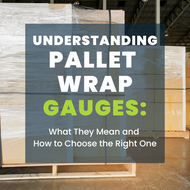20th Feb 2025
When it comes to securing products for shipping or storage, pallet wrap (also known as stretch film) plays a crucial role. However, choosing the right pallet wrap can be confusing, especially when you're faced with terms like "gauge." Understanding what gauge means and how it affects your packaging decisions can help you select the best option for your needs. In this blog, we break down the concept of gauge and guide you through the selection process.
What Is Gauge?
Simply put, gauge refers to the thickness of the pallet wrap. It is traditionally measured in mils, with one mil equaling one-thousandth of an inch (0.001 inch). The gauge of the film influences its strength, stretchability, and durability. In general, a higher gauge means a thicker and stronger wrap, while a lower gauge indicates a thinner and lighter film.
Why Does Gauge Matter?
Choosing the correct gauge is essential because it affects:
- Load Security: Thicker films provide better containment, preventing products from shifting during transport.
- Puncture Resistance: Heavier gauges offer more resistance against sharp edges and rough handling.
- Cost Efficiency: Using a gauge that is too thick for your application wastes material and money, while a gauge that's too thin may not adequately protect your products.
- Ease of Use: Thinner gauges are easier to handle and apply, especially for manual wrapping.
Common Pallet Wrap Gauges and Their Applications
Here’s a breakdown of common gauges and when to use them:
60 Gauge:
- Best for: Light-duty wrapping and bundling small items.
- Load Weight: Up to ~1,600 lbs.
- Use Case: Ideal for products that need basic protection from dust and minor scuffs.
70 Gauge:
- Best for: Light-to-medium duty applications.
- Load Weight: Up to ~2,200 lbs.
- Use Case: Suitable for uniform loads without sharp edges; common in retail and general warehousing.
80 Gauge: (The Industry Standard)
- Best for: Versatile, all-purpose wrapping.
- Load Weight: Up to ~2,400 lbs.
- Use Case: Perfect for most shipping needs; balances strength, stretch, and cost.
90-120 Gauge:
- Best for: Heavy-duty applications requiring maximum load security.
- Load Weight: Over 3,000 lbs.
- Use Case: Suitable for irregular loads, heavy equipment, and items with sharp edges.
What Do Gauge, Mil, and Micron Mean?
All three terms—gauge, mil, and micron—refer to the thickness of the pallet wrap, which directly affects its strength, stretchability, and durability. However, they are used in different regions and industries:
- Gauge: Commonly used in the U.S., especially in the packaging industry.
- Mil: Another U.S. measurement, with one mil equal to one-thousandth of an inch (0.001 inch).
- Micron: Widely used internationally and in scientific contexts; one micron equals one-thousandth of a millimeter (0.001 mm).
How Do Gauge, Mil, and Micron Compare?
Understanding how these measurements convert can simplify the selection process. Here’s how they relate:
- 1 Gauge ≈ 0.254 Microns
- 100 Gauge ≈ 25.4 Microns ≈ 1 Mil
Below is a quick reference table to compare these units:
|
Gauge |
Mil |
Micron |
Typical Application |
|
60 Gauge |
0.60 |
15 |
Light-duty, bundling small items |
|
70 Gauge |
0.70 |
18 |
Light-to-medium duty wrapping |
|
80 Gauge |
0.80 |
20 |
General-purpose, standard wrapping |
|
90 Gauge |
0.90 |
23 |
Heavy loads, moderate sharp edges |
|
120 Gauge |
1.20 |
30 |
Heavy-duty, irregular-shaped loads |
Tips for Choosing the Right Gauge
- Assess Your Load: Consider the weight, shape, and sharpness of the products.
- Evaluate Transportation Risks: Longer or rougher shipping routes may require a higher gauge.
- Factor in Application Method: Manual wrapping often benefits from thinner, pre-stretched films for ease of use.
- Consider Cost vs. Performance: Thicker isn’t always better; choose a gauge that provides sufficient protection without excess.
Understanding pallet wrap gauges is key to making informed decisions that protect your products and optimize costs. By selecting the right gauge, you ensure that your shipments are secure while minimizing waste and expense. Whether you need a light-duty film for simple bundling or a heavy-duty wrap for demanding applications, there’s a gauge that fits your needs.
Need help selecting the perfect pallet wrap? Contact us today and let our experts guide you to the right solution for your business.
